Comparative Study of Laser-Arc Hybrid Welding for AA6082-T6 Aluminum Alloy with Two Different Arc Modes
Abstract
1. Introduction
2. Materials and Experimental Details
2.1. Materials
2.2. Welding Method and Apparatus
2.3. Testing Examination
3. Results and Discussion
3.1. Weld Formation
3.2. Microstructure Characteristics
3.3. Microhardness Distribution
3.4. Mechanical Properties
4. Conclusions
Author Contributions
Funding
Conflicts of Interest
References
- Wang, Q.; Chen, H.; Zhu, Z.; Qiu, P.; Cui, Y. A characterization of microstructure and mechanical properties of A6N01S-T5 aluminum alloy hybrid fiber laser-MIG welded joint. Int. J. Adv. Manuf. Technol. 2016, 86, 1375–1384. [Google Scholar] [CrossRef]
- Gou, G.; Huang, N.; Chen, H.; Liu, H.; Tian, A.; Guo, Z. Research on corrosion behavior of A6N01S-T5 aluminum alloy welded joint for high-speed trains. J. Mech. Sci. Technol. 2012, 26, 1471–1476. [Google Scholar] [CrossRef]
- Bunaziv, I.; Frostevarg, J.; Akselsen, O.M.; Kaplan, A.F.H. Process stability during fiber laser-arc hybrid welding of thick steel plates. Opt. Laser Eng. 2018, 102, 34–44. [Google Scholar] [CrossRef]
- Leo, P.; Renna, G.; Casalino, G.; Olabi, A.G. Effect of power distribution on the weld quality during hybrid laser welding of an Al-Mg alloy. Opt. Laser Technol. 2015, 73, 118–126. [Google Scholar] [CrossRef]
- Bunaziv, I.; Akselsen, O.M.; Salminen, A.; Unt, A. Fiber laser-MIG hybrid welding of 5 mm 5083 aluminum alloy. J. Mater. Process. Technol. 2016, 233, 107–114. [Google Scholar] [CrossRef]
- Cornacchia, G.; Cecchel, S.; Panvini, A. A comparative study of mechanical properties of metal inert gas (MIG)-cold metal transfer (CMT) and fiber laser-MIG hybrid welds for 6005A T6 extruded sheet. Int. J. Adv. Manuf. Technol. 2018, 94, 2017–2030. [Google Scholar] [CrossRef]
- Fu, B.; Qin, G.; Meng, X.; Ji, Y.; Zou, Y.; Lei, Z. Microstructure and mechanical properties of newly developed aluminum-lithium alloy 2A97 welded by fiber laser. Mater. Sci. Eng. A 2014, 617, 1–11. [Google Scholar] [CrossRef]
- Dittrich, D.; Jahn, A.; Standfuss, J.; Beyer, E. Laser beam welding of atmosphere aluminum die cast material using high frequency beam oscillation and brilliant beam sources. J. Laser Appl. 2018, 29, 022425. [Google Scholar] [CrossRef]
- Caruso, S.; Sgambitterra, E.; Rinaldi, S.; Gallone, A.; Viscido, L.; Filice, L.; Umbrello, D. Experimental comparison of the MIG, friction stir welding, cold metal transfer and hybrid laser-MIG processes for AA 6005-T6 aluminium alloy. AIP Conf. Proc. 2016, 1769, 100004. [Google Scholar] [CrossRef]
- Sun, Z.; Kuo, M. Bridging the joint gap with wire feed laser welding. J. Mater. Process. Technol. 1999, 87, 213–222. [Google Scholar] [CrossRef]
- Schultz, V.; Seefeld, T.; Vollertsen, F. Gap bridging ability in laser beam welding of thin aluminum sheets. Phys. Procedia 2014, 56, 545–553. [Google Scholar] [CrossRef]
- Acherjee, B. Hybrid laser arc welding: State-of-art review. Opt. Laser Technol. 2018, 99, 60–71. [Google Scholar] [CrossRef]
- Casalino, G.; Mortello, M.; Leo, P.; Benyounis, K.Y.; Olabi, A.G. Study on arc and laser powers in the hybrid welding 0f AA5754 Al-alloy. Mater. Des. 2014, 61, 191–198. [Google Scholar] [CrossRef]
- Ascari, A.; Fortunato, A.; Orazi, L.; Campana, G. The influence of process parameters on porosity formation in hybrid laser-GMA welding of AA6082 aluminum alloy. Opt. Laser Technol. 2012, 44, 1482–1490. [Google Scholar] [CrossRef]
- Tang, G.; Chen, H.; Yang, X.; Shen, L. Effects of different welding process on the electronic temperature of plasma and weld shape during laser-MIG hybrid welding of A7N01P-T4 aluminum alloy. J. Laser Appl. 2018, 30, 022002. [Google Scholar] [CrossRef]
- Gu, X.; Li, H.; Yang, L.; Gao, Y. Coupling mechanism of laser and arcs of laser-twin-arc hybrid welding and its effect on welding process. Opt. Laser Technol. 2013, 48, 246–253. [Google Scholar] [CrossRef]
- Kim, Y.P.; Alam, N.; Bang, H.S.; Bang, H.S. Observation of hybrid (cw Nd: YAG laser plus MIG) welding phenomenon in AA 5083 butt joints with different gap condition. Sci. Technol. Weld. Join. 2006, 11, 295–307. [Google Scholar] [CrossRef]
- Wang, J.; Nishimura, P.; Fujii, K.; Katayama, S.; Mizutani, M. Study of improvement of gap tolerance in laser-MIG arc hybrid welding of aluminum alloy. Weld. Int. 2008, 23, 723–733. [Google Scholar] [CrossRef]
- Li, D.; Ji, H.; Liu, Y.; Gou, G.; Chen, H.; Liu, J.; Bo, M.; Li, C. Simulation on temperature and residual stress field of laser-MIG hybrid welding of A6N01-T5 alloy. Adv. Mater. Res. 2011, 399–401, 2040–2043. [Google Scholar] [CrossRef]
- Yan, S.; Chen, H.; Zhu, Z.; Gou, G. Hybrid laser-Metal Inert Gas welding of Al-Mg-Si alloy joints: Microstructure and mechanical properties. Mater. Des. 2014, 61, 160–167. [Google Scholar] [CrossRef]
- Wang, Y.Q.; Tan, B.; Ma, B.; Ma, Z.H. The deformation simulation of the laser-MIG hybrid welding in fillet-welded joint. Appl. Mech. Mater. 2012, 117–119, 1566–1570. [Google Scholar] [CrossRef]
- Cai, C.; Feng, J.; Li, L.; Chen, Y. Influence of laser on the droplet behavior in short-circuiting, globular, and spray modes of hybrid fiber laser-MIG welding. Opt. Laser Technol. 2016, 83, 108–118. [Google Scholar] [CrossRef]
- .Selvi, S.; Vishvaksenan, A.; Rajasekar, E. Cold metal transfer (CMT) technology—An overview. Defin. Technol. 2018, 14, 30–46. [Google Scholar]
- Pickin, C.G.; Young, K. Evaluation of cold metal transfer (CMT) process for welding aluminium alloy. Sci. Technol. Weld. Join. 2006, 11, 583–585. [Google Scholar] [CrossRef]
- Feng, J.; Zhang, H.; He, P. The CMT short-circuiting metal transfer process and its use in thin aluminium sheets welding. Mater. Des. 2009, 30, 1850–1852. [Google Scholar] [CrossRef]
- Meco, S.; Pardal, G.; Eder, A.; Quintino, L. Software development for prediction of the weld bead in CMT and pulsed-MAG processes. Int. J. Adv. Manuf. Technol. 2013, 64, 171–178. [Google Scholar] [CrossRef]
- Lamas, J.; Frostevarg, J.; Kaplan, A.F.H. Gap bridging for two modes of laser arc hybrid welding. J. Mater. Process. Technol. 2015, 224, 73–79. [Google Scholar] [CrossRef]
- Li, G.; Zhang, C.; Gao, M.; Zeng, X. Role of arc mode in laser-metal active gas arc hybrid welding of mild steel. Mater. Des. 2014, 61, 239–250. [Google Scholar] [CrossRef]
- Zhang, C.; Li, G.; Gao, M.; Yan, J.; Zeng, X.Y. Microstructure and process characterization of laser-cold metal transfer hybrid welding of AA6061 aluminum alloy. Int. J. Adv. Manuf. Technol. 2013, 68, 1253–1260. [Google Scholar] [CrossRef]
- IOS. Metallic Materials—Tensile Testing—Part 1: Method of Test at Room Temperature; International Organization for Standardization: Geneva, Switzerland, 2010. [Google Scholar]
- Gao, M.; Cao, Y.; Zeng, X.Y.; Lin, T.X. Mechanical properties and microstructures of hybrid laser MIG welded dissimilar Mg-Al-Zn alloys. Sci. Technol. Weld. Join. 2010, 15, 638–645. [Google Scholar] [CrossRef]
- Gärtner, P.; Weber, R. Spatter Formation and Keyhole Observation with High Speed Cameras-Better Understanding of the Keyhole Formation. In Proceedings of the 28th International Congress on Laser Materials Processing, Laser Microprocessing and Nanomanufacturing, Orlando, FL, USA, 2–5 November 2009; pp. 339–342. [Google Scholar]
- David, S.A.; Vitek, J.M. Correlation between solidification parameters and weld microstructures. Int. Mater. Rev. 1989, 34, 213–245. [Google Scholar] [CrossRef]
- Wu, N.Q.; Xia, C.; Li, M.; Perrusquia, N.; Mao, S.X. Interfacial structure and micro and nano-mechanical behaviour of laser-welded 6061 aluminum alloy blank. J. Eng. Mater. Technol. 2004, 126, 8–13. [Google Scholar] [CrossRef]
- ISO. Destructive Tests on Welds in Metallic Materials—Hardness Testing—Part 2: Microhardness Testing of Welded Joints; International Organization for Standardization: Geneva, Switzerland, 2016. [Google Scholar]
- Kuo, T.Y.; Lin, H.C. Effects of pulse level of Nd-YAG laser on tensile properties and formability of laser weldments in automotive aluminum alloys. Mater. Sci. Eng. A 2006, 416, 281–289. [Google Scholar] [CrossRef]
- Yang, Z.; Zhao, X.; Tao, W.; Jin, C.; Huang, S.; Wang, Y.; Zhang, E. Comparative study on successive and simultaneous double-sided laser beam welding of AA6056/AA6156 aluminum alloy T-joints for aircraft fuselage panels. Int. J. Adv. Manuf. Technol. 2018, 97, 845–856. [Google Scholar] [CrossRef]
- Xin, Z.; Yang, Z.; Zhao, H.; Chen, Y. Comparative study on welding characteristics of laser-CMT and plasma-CMT hybrid welded AA6082-T6 aluminum alloy butt joints. Materials 2019, 12, 3300. [Google Scholar] [CrossRef]
- Li, F.; Feng, S.; Li, M.; Zhu, Y. Softening phenomenon of heat-affected zone in laser welding of 6082 Al alloys with filler wire. Chin. J. Lasers 2018, 45, 1102007. [Google Scholar] [CrossRef]
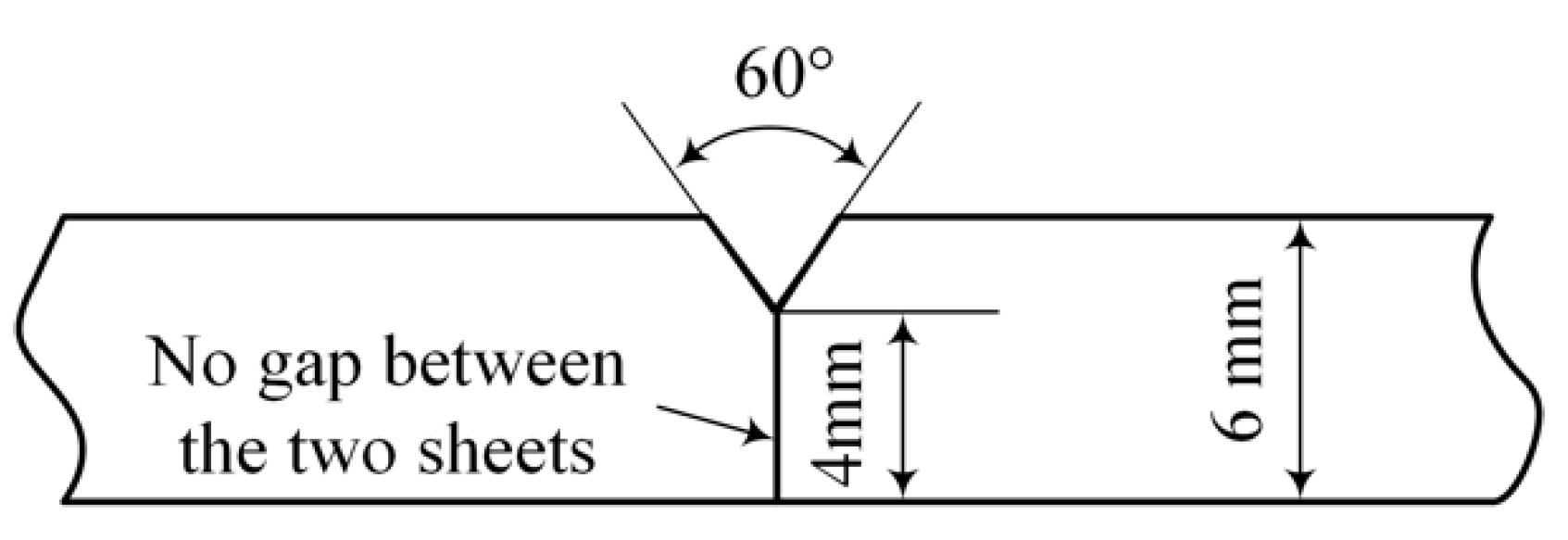



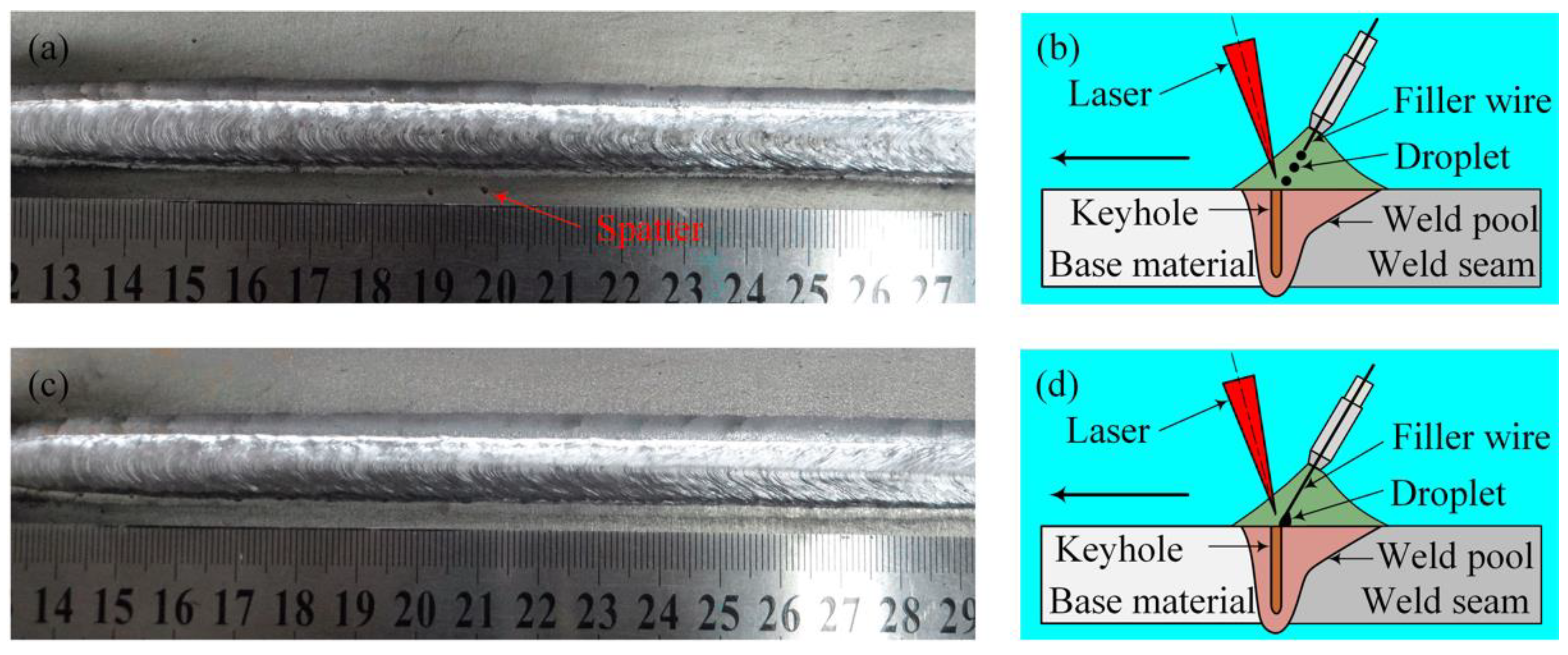
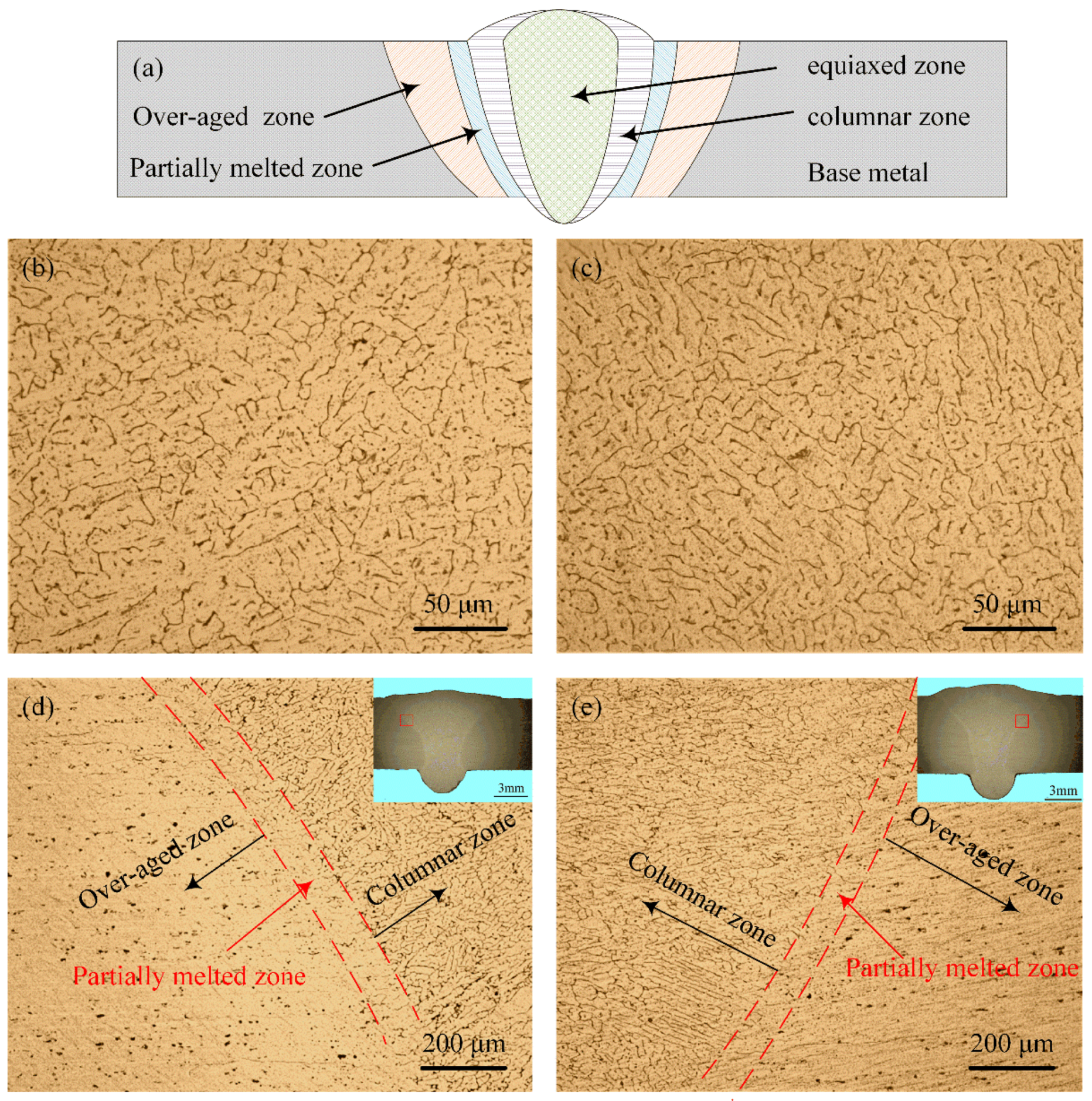
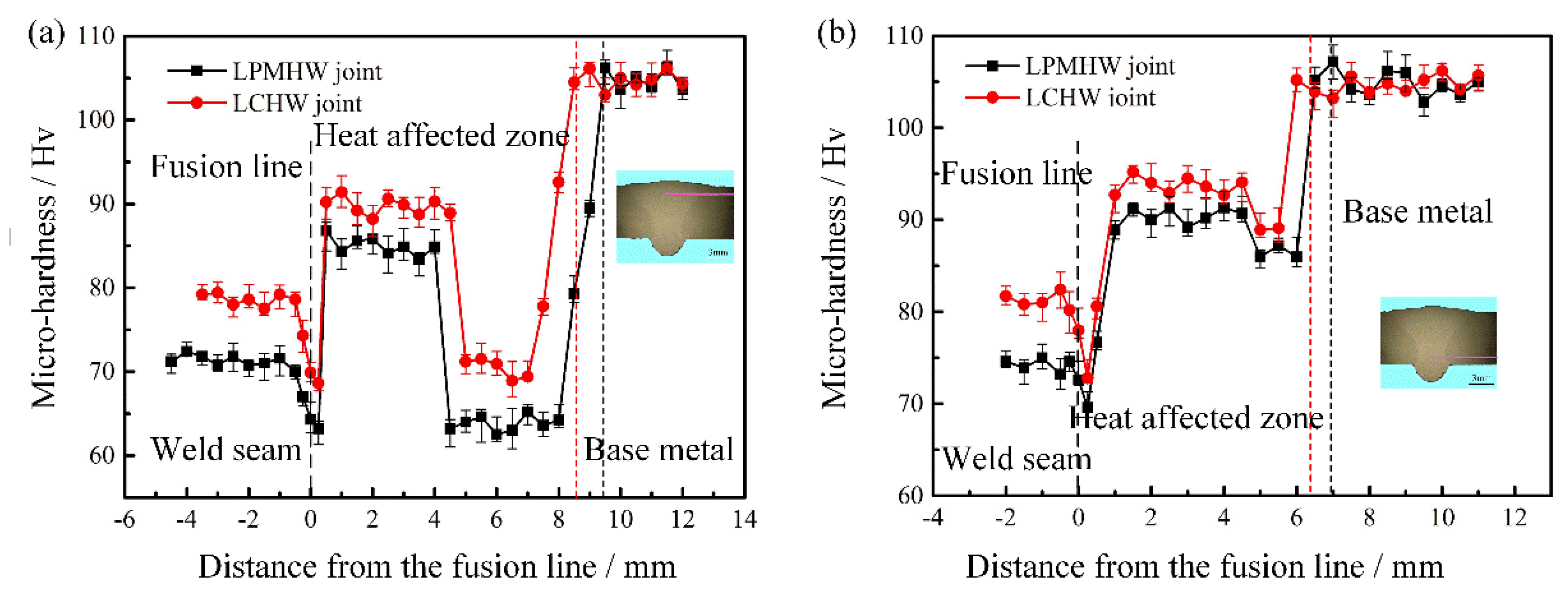
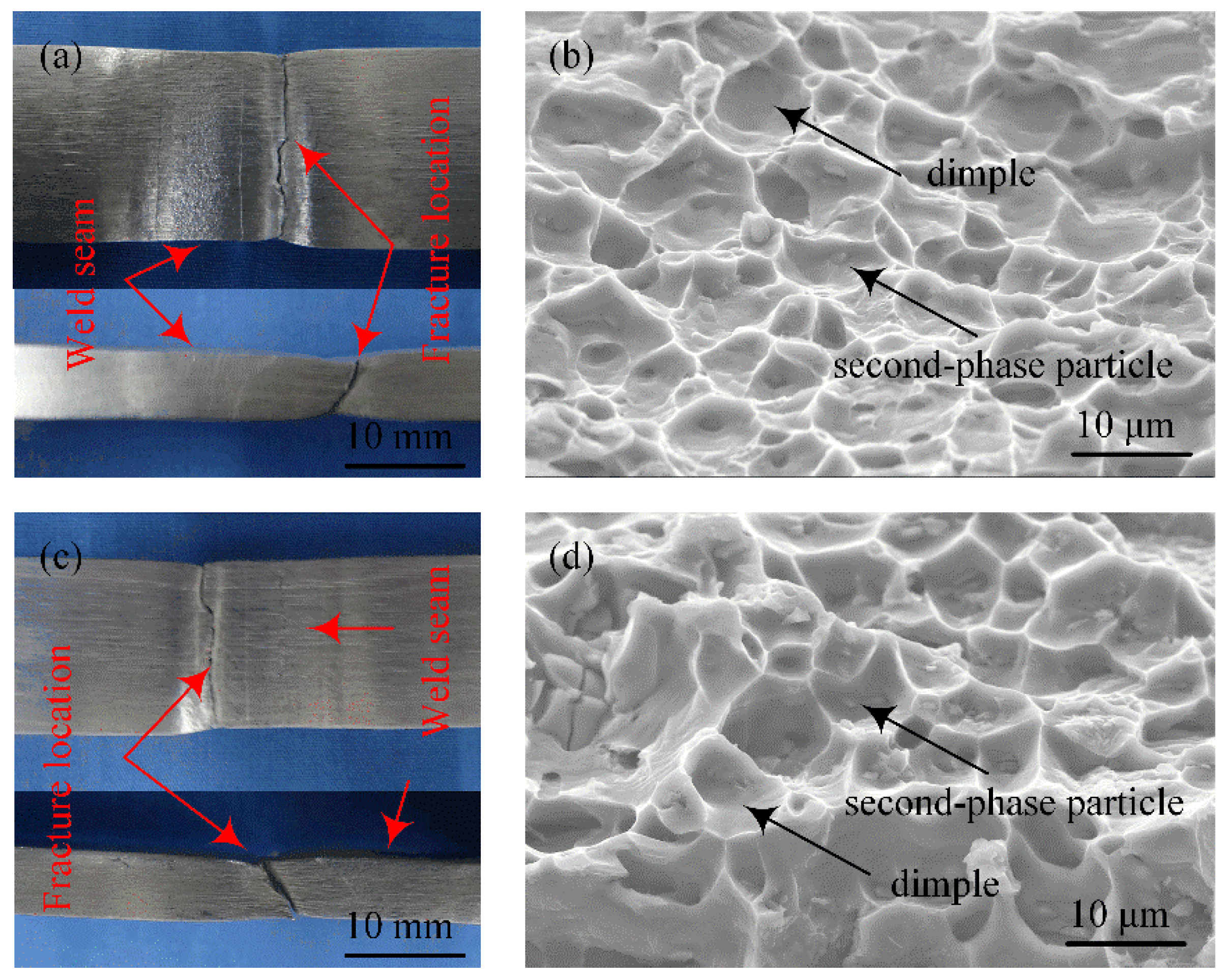
| Materials | Si | Fe | Cu | Mn | Mg | Cr | Zn | Ti | Al |
|---|---|---|---|---|---|---|---|---|---|
| AA6082-T6 | 0.97 | 0.37 | 0.07 | 0.67 | 1.02 | 0.01 | 0.06 | 0.01 | Bal. |
| ER5356 | 0.10 | 0.40 | 0.10 | 0.15 | 4.8 | 0.1 | 0.1 | 0.13 | Bal. |
| Welding Parameters | LPMHW | LCHW |
|---|---|---|
| Laser power (kW) | 2.4 | 2.4 |
| Welding speed (m/min) | 0.72 | 0.72 |
| Wire feeding speed (m/min) | 7.5 | 6.5 |
| Welding current (A) | 130 | 114 |
| Welding voltage (U) | 18.8 | 14.3 |
| Defocus distance (mm) | 2 | 2 |
| Heat source distance (mm) | 3 | 3 |
| Heat input (kJ/cm) | 3.03 | 2.55 |
| Dimensions | LPMHW | LCHW |
|---|---|---|
| Weld penetration of the arc zone (Pa/mm) | 3.5 | 3.1 |
| Weld penetration of the laser zone (Pl/mm) | 2.5 | 2.9 |
| Weld width of the front surface (Wf/mm) | 10.8 | 10.0 |
| Weld width of the back surface (Wb/mm) | 4.5 | 3.8 |
| Reinforcement of the front surface (Rf /mm) | 0.7 | 1.0 |
| Reinforcement of the back surface (Rb/mm) | 2.1 | 2.2 |
| Welding Method | Specimen Number | Tensile Strength (MPa) | Joint Efficiency (%) | Elongation (%) | Fracture Location | ||
|---|---|---|---|---|---|---|---|
| Single | Average | Single | Average | ||||
| LPMHW | LPMHW-1# | 260.1 | 255.1 | 82.4 | 9.4 | 8.6 | Heat-affected zone |
| LPMHW-2# | 251.3 | 8.1 | Heat-affected zone | ||||
| LPMHW-3# | 254.0 | 8.3 | Heat-affected zone | ||||
| LCHW | LCHW-1# | 259.4 | 262.5 | 84.7 | 9.8 | 9.4 | Heat-affected zone |
| LCHW-2# | 264.7 | 8.9 | Heat-affected zone | ||||
| LCHW-3# | 263.5 | 9.6 | Heat-affected zone | ||||
© 2020 by the authors. Licensee MDPI, Basel, Switzerland. This article is an open access article distributed under the terms and conditions of the Creative Commons Attribution (CC BY) license (http://creativecommons.org/licenses/by/4.0/).
Share and Cite
Han, X.; Yang, Z.; Ma, Y.; Shi, C.; Xin, Z. Comparative Study of Laser-Arc Hybrid Welding for AA6082-T6 Aluminum Alloy with Two Different Arc Modes. Metals 2020, 10, 407. https://doi.org/10.3390/met10030407
Han X, Yang Z, Ma Y, Shi C, Xin Z. Comparative Study of Laser-Arc Hybrid Welding for AA6082-T6 Aluminum Alloy with Two Different Arc Modes. Metals. 2020; 10(3):407. https://doi.org/10.3390/met10030407
Chicago/Turabian StyleHan, Xiaohui, Zhibin Yang, Yin Ma, Chunyuan Shi, and Zhibin Xin. 2020. "Comparative Study of Laser-Arc Hybrid Welding for AA6082-T6 Aluminum Alloy with Two Different Arc Modes" Metals 10, no. 3: 407. https://doi.org/10.3390/met10030407
APA StyleHan, X., Yang, Z., Ma, Y., Shi, C., & Xin, Z. (2020). Comparative Study of Laser-Arc Hybrid Welding for AA6082-T6 Aluminum Alloy with Two Different Arc Modes. Metals, 10(3), 407. https://doi.org/10.3390/met10030407





